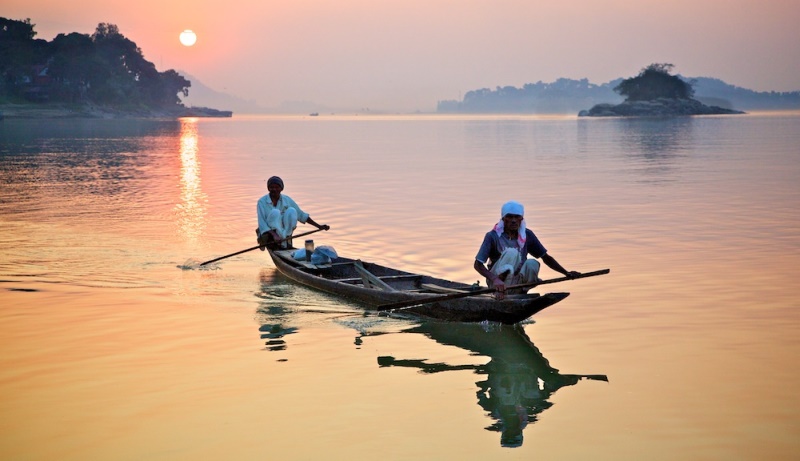
Located in the North-eastern part of India, Assam (Vernacular: Oxom) is bounded by the Kingdom of Bhutan and Arunachal Pradesh in the north, Nagaland and Manipur in the east, Mizoram and Tripura in the south and Meghalaya, West Bengal and Bangladesh in the west.
Covering an area of 78,438 sq. km, Assam is administratively divided into 33 districts as of 2018. The total number of districts till 2015 were 27. The districts of Biswanath was carved out of Sonitpur, Charaideo from Sibsagar, Hojai from Nagaon, South Salmara-Mankachar from Dhubri and West Karbi Anglong from Karbi Anlong. Later, in June 2016, Majuli was declared as a district, making it the only river island district in India.
With a total population of 3,11,69,272, Assam is home to a plethora of tribes and ethno-cultural groups including Karbi, Bodo, Dimasa, Mishing, Rabha, Tiwa, Singphow, Hasong etc. practicing distinct culture and lifestyles, apart from the hybrid Assamese group. Witnessing the confluence of diversified cultures since time immemorial, the illegal immigration of Bangladeshis has been a matter of grave concern, against which agitation was started in Assam as early as 1970s. The illegal migrants from the neighbouring country are often blamed for taking away job opportunities and other resources as they are often found to huddle near the urban areas in an unprecedented manner.
Although divided into 4 main regions, one can broadly generalise the state into the regions of Upper Assam and Lower Assam. Upper Assam (Vernacular: Ujoni Oxom) comprises the eastern districts of Dibrugarh, Jorhat, Golaghat, Dhemaji, Lakhimpur, Charaideo, Sivasagar, Majuli, and Tinsukia and Lower Assam (Vernacular: Namoni Oxom) includes the western districts of Bongaiagon, Kokrajhar, Darang, Goalpara, Baksa, Morigaon, Chirrang, Udalgiri, Barpeta, Kamrup, and Nalbari.
The vast plains of Assam are referred to as Pragjyotishpura in various ancient texts and scriptures. One Gait (1992, reprint) writes that Prag means eastern or former and Jyotisha maens a star, astrology or shining. Thus the term literally means City of Eastern Astrology. Another name used for Assam and younger than Pragjyotishpura is Kamarupa. References of Kamarupa too have been found in the two great epics and in other literature.
In early thirteenth century, the Mughals proceeded to Kamarupa after conquering Bengal. In the meantime a powerful dynasty in the eastern part of the state, which ruled Assam for almost 600 years, emerged and came into conflict with the Mughals several times. The boundaries of Assam – which remained impervious till 1826 – began with a series of annexations and successions after the Treaty of Yandaboo signed between the British and the Burmese Empire in 1826. Consequently, in 1874, with Shillong (presently in Meghalaya) as its capital, Assam became a separate province. Meghalaya, Nagaland, Arunachal Pradesh and Mizoram had their own separate states.
In 1901, the first oil refinery in Asia and second in the whole world was built at Digboi and today its oil fields and refinery are the longest producing in the world.
Based on physiography, Assam can be divided into hills and plains. While the climate in the plains is predominately humid and tropical type, it is pleasant sub alpine type in the hills. Experiencing heavy monsoon downpours, Assam’s annual average rainfall is among the highest in the country. It is due to high rainfall coupled with high temperatures in low altitudes that leads to high acid content in the soils of Assam. New alluvial, old alluvial, red loam and laterite soils can be found across the state depending on the nature of topography and relief, rainfall, cultivation etc.
Assam is among the richest biodiversity zones in the world. The State is glutted with tropical and deciduous forests, wetlands, riverine grasslands etc. Kaziranga National Park, home to the rare one horned rhinoceros and Manas National Park, primarily a tiger reserve, are declared as UNESCO World Heritage Sites. The sumptuousness of flora and fauna has led intellectuals to describe Assam as the Biological Gateway of North-east India. Various species of orchids, including foxtail orchid (vernacular: kopou phool) which is the state flower, and valuable plant species are found here. While deer, leopard, gibbons, golden langur, elephants, porcupines, pygmy hogs etc. are found across the forest ecosystem. Gangetic river dolphins are also abundantly found in the Brahmaputra and it is the city animal of Guwahati.
The lifeline of the state, River Brahmaputra is one of the biggest rivers in the country. Known as the Tsangpo in China, Siang in Arunachal Pradesh and Jamuna in Bangladesh, Brahmaputra forms a complex river system. Both the largest and smallest riverine islands of the world, Majuli and Umananda are found in this same perennial river. The second largest river system in the North-east as well as in Assam, the Barak River rises on the southern slope of the lofty Barail Range near the border of Manipur and Nagaland.
Due to the unique geo-climatic conditions, Assam experiences floods, erosion of embankments, landslide etc. among other environmental havoc almost every year. Supposedly, the sole reason for floods i.e., drainage congestion, is heavy precipitation of short duration and higher flood level in the main river. With nearly 66% of the working population deriving their livelihood from agriculture, perennial floods not only bring losses to lives and property but also to livestock and food stock, which sometimes leads to starvation for indefinite period of time. Another issue of landslides arises due to the growth of population and construction of houses in the immature soils and steep slopes in the hills of Guwahati. Earthquakes and deforestation are two other threats faced by Assam.
Guwahati, the gateway of north east and also the state capital, features some interesting sites including the Kamakhya temple, Sualkuchi, Hajo etc. Sibsagar (now Sivasagar), the ancient capital of the Ahom kingdom treasures ancient heritage sites like the Rang Ghar, Talatal Ghar, Shiva idol etc. The extensive expanses of tea plantations, especially in Upper Assam, are not just among the largest contributors to the state economy but also a sight to behold.
Article by Prahelika Deka. Image by M Foley via Flickr
